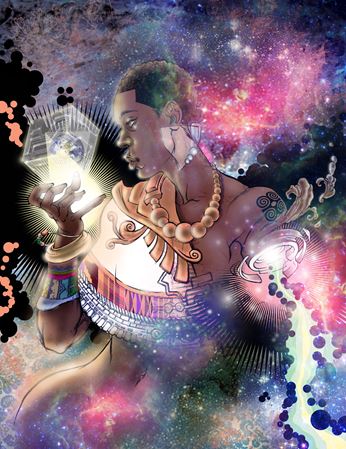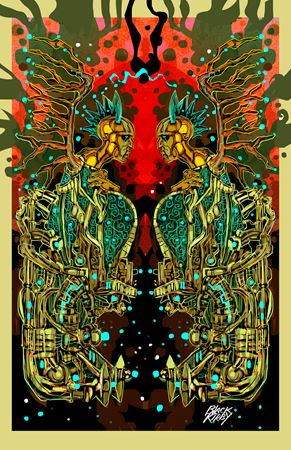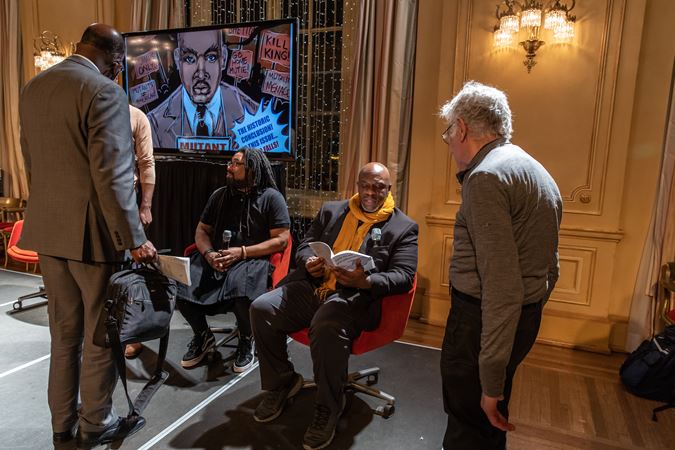Black Kirby co-founder John Jennings appears in a video greeting before a pre-concert talk in Grainger Ballroom with (from left) moderator Kate McDuffie, composer Carlos Simon, store owner Terry Gant and Stacey Robinson, also of Black Kirby.
Elliot Mandel
American artist Jack Kirby created many of the characters of the Marvel Comics universe, including the Fantastic Four, the Hulk, Ant-Man, Thor, Iron Man, X-Men, Silver Surfer and Black Panther.
That’s a world that until recently was dominated by white males. So the creative duo of John Jennings and Stacey Robinson wondered, “Where are all the Black people in comics?” To address that issue, Jennings and Robinson decided to collaborate as Black Kirby and explore comics icon Jack Kirby’s work through a lens of Afrofuturism. (Coined by writer Mark Dery in 1994, Afrofuturism describes a genre that introduces African diaspora sensibilities into science fiction, fantasy and magical realism literary, visual, video and cinematic artworks.)
On Dec. 19, the Civic Orchestra of Chicago performed Grammy-nominated composer Carlos Simon’s Tales: A Folklore Symphony, along with Rachmaninov’s Symphony No. 1 in a concert titled Spiritual Awakenings. Simon’s Tales weaves together the past, present and future of Black life and artistry.
Ahead of Spiritual Awakenings, Carlos Simon and Black Kirby artist Stacey Robinson convened at Symphony Center with Terry Gant, owner of Third Coast Comics in Chicago’s Rogers Park neighborhood, for a discussion about the principles of Afrofuturism. Also attending the preconcert conversation was Ytasha Womack, Chicago-based artist and Afrofuturist author and scholar.
The discussion began with a video greeting from Black Kirby co-creator John Jennings, who introduced the work that he and Robinson created for the curated collection Black Kirby: In Search of the Motherboxx Connection. During the session, parallels between Black Kirby’s Afrofuturist images and Simon’s A Folklore Symphony were revealed as vibrant visions of the past, present and future provided a backdrop to the evening’s conversation.
The symphony’s four movements quote popular hymns, well-known spirituals and driving work songs in movements titled “Flying Africans,” “Go Down Moses” and “John Henry.” The first movement is titled “MOTHERBOXX CONNECTION,” a musical representation of the Afrofuturist imaginings of Robinson and Jennings.
In his program notes, Simon writes: “Based heavily in Afrofuturism, Black Kirby’s characters show Black people as heroes using ancient customs and futurist motifs from the African and African American diaspora. This piece is inspired by the many heroic characters found in the work of Black Kirby, but mainly Motherboxx Connection.”
According to scholar Regina N. Bradley, the Motherboxx Connection is “a pun on Jack Kirby’s motherbox, a living computer connected to the world; the Motherboxx, too, is a living computer with a heightened awareness of racial and sexual discourses surrounding the Black body. The motherboxx is the technological equivalent of the ‘mother land’ in the Black diaspora imagination. She is where Black identities merge and depart.”
In his program notes, Simon also writes: “To represent the power and intelligence of the motherboxx, I have composed a short, fast-moving musical idea that constantly weaves in and throughout the orchestra. A majestic, fanfare-like motif also provides the overall mood of strength and heroism. I imagine the motherboxx as an all-knowing entity that is aware of the multi-faceted aspects of blackness.”
During the pre-concert talk, works by Black Kirby were displayed and discussed. In their notes for Black Kirby: In Search of the Motherboxx Connection (2015), Jennings and Robinson wrote: “This collection of work samples from (Jack) Kirby’s style but also remixes it with the formal and conceptual influences from many other artists, pop-culture comic and artistic expressions. In a sense, Black Kirby uses the comics medium as a conceptual crossroads to examine identity as a socialized concept through bricolage, pastiche, oppositional juxtapositions and deconstruction. It is the artists’ hope to stabilize various ideas of blackness in order to examine certain nuances of its performance.”
As a Black Kirby artwork is projected on a video screen, Terry Gant (second from right), owner of Chicago's Third Coast Comics, discusses the rise of Black graphic artists during a pre-concert panel in Grainger Ballroom.
Elliot Mandel
About the duo Black Kirby:
Stacey A. Robinson, MFA, born in Albany, New York, is an associate professor of graphic design at the University of Illinois at Urbana-Champaign. Themes of science fiction, Black liberation politics and comic books have influenced his artistic practice.
He moved to New York City the day that hip-hop icon Tupac Shakur died and the next day became an intern for Milestone Media Inc., a Black-owned comic book company that has influenced many of today’s comic creators. Soon after he interned at Black Enterprise magazine and Acclaim Comics. He moved to Fayetteville, North Carolina, where he attained his associate and bachelor degrees while working professionally as a graphic designer. In 2013, he received a full scholarship and the Arthur Schomburg Fellowship to attend the University at Buffalo, where he began to theorize his practice.
John Jennings is a professor, author, graphic novelist, curator, Harvard Fellow, New York Times best seller, 2018 Eisner Winner and all-around champion of Black culture.
As professor of media and cultural studies at the University of California at Riverside, Jennings examines the visual culture of race in various media forms, including film, illustrated fiction, and comics and graphic novels. He is also the director of Abrams ComicArts imprint Megascope, which publishes graphic novels focused on the experiences of people of color. His research interests include the visual culture of hip hop, Afrofuturism and politics, visual literacy, horror and the ethno-gothic, and speculative design and its applications to visual rhetoric.
Jennings is co-editor of the 2016 Eisner Award-winning collection The Blacker the Ink: Constructions of Black Identity in Comics and Sequential Art (Rutgers) and co-founder and organizer of The Schomburg Center’s Black Comic Book Festival in Harlem. He is co-founder and organizer of the MLK NorCal’s Black Comix Arts Festival in San Francisco and also SOL-CON: The Brown and Black Comix Expo at the Ohio State University.






